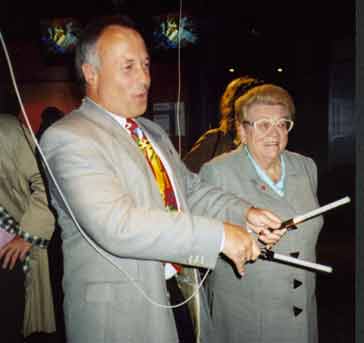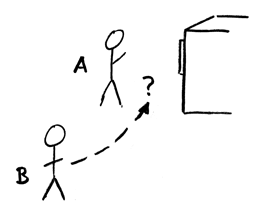| back to index | |||
H4 Easy Handover * |
|||
 A visitor waiting for her turn to use WorldBeat. |
|||
|
...you have found a way to attract users if the system is not
presently in use - AttractionSpace, and how
to engage them and convey the system's messages to them - ClosedLoop. Now you have to think about the situation when a
user wants to "take over" from the previous visitor, a common situation in busy environments.
|
|||
|
* * *
|
|||
| Most interactive systems implicitly assume that each user
begins using their system from a start page or initial state. At
interactive exhibits, however, one user often takes over from the
previous one, possibly in the middle of the interaction, and without
knowing the interaction history of the previous user.
|
|||
|
Most traditional, desktop-oriented interactive systems can be designed from a point of view where a user initiates the interaction from a defined starting point (for example by launching an application). Moreover, a typical user accesses such a system many times, and already knows something about the system when he accesses it. |
|||
| User change in middle of interaction |
At interactive exhibits, on the other hand, one user often leaves the "controls" to the next user without returning the system to its "idle" or initial state of interaction. This may happen because the first user wants the second user to "try out what I am just doing" (especially if he knows the other one), or he feels social pressure to leave the system for others who are waiting for their turn. In the WorldBeat system, for example, visitors often take the batons from their predecessor while that user is in the middle of interacting with one of the system features. The two possible actions then (which have both been observed) are either that the new user continues to use the same feature (e.g., conducting), or that he uses the "back" button and chooses a different feature. |
||
| WorldBeat: No user-specific state |
WorldBeat supports the first alternative by a design that has no user-specific state. The only state that users can create in a system is the position within the hierarchy of features (e.g., the fact that "conducting" is the currently active feature) and the settings of the controls within this feature (e.g., the solo instrument selected in the improvisation module). No personal data, such as names or digital photos of the user, is created in the system, so the user who takes over has no need to "reset" those values to his own settings. |
||
| Back button |
The second alternative is supported by a "back" button that is available on every page of the system, and that always leads back up the hierarchical menu tree of available features. In both cases, the new user cannot be expected to have seen the introductory screen explaining how the batons are used. This knowledge, however, is something that the new user has already gathered from watching his predecessor using the exhibit before taking over. |
||
| Virtual Vienna |
The Virtual Viennaexhibit, which lets users take a virtual tour of the city of Vienna, uses an even more stateless approach. The only parameters that users change by interacting with the exhibit are the current geographical position within the virtual environment, and the choice of language for the interface. It is not necessary to return to a specific "starting" point in the application to begin using the system, and the language can be changed at any time through a button that is always available. |
||
| BACK TO A SAFE PLACE |
The HCI pattern collection by Tidwell [1998] contains a pattern BACK TO A SAFE PLACE, which represents a similar idea.
It recommends to always supply users with a simple means of getting back to an
initial, known, or otherwise "secure" state if they get lost in
the course of interaction.
|
||
|
Therefore: Minimize the dialogue history that a new user needs to know to begin using an interactive exhibit. Offer a simple means to return the system to its initial state. If critical, user-specific parameters such as language need to be set by a user, let users change the setting at any time, no matter where they are in the system. |
|||
 |
|||
|
* * *
|
|||
|
If your system needs to present a multitude of information units (such as screen pages), arrange them so a new user
can quickly find his way back to the main selection - Flat And Narrow Tree. Minimize using information forms that
depend on language or culture, at least for the basic information
necessary to operate the exhibit and set the language - Language Independence.
|
|||
This pattern is taken from the book "A Pattern Approach to Interaction Design" (PAID) by Jan Borchers (John Wiley and Sons, Chichester, UK, 2001). Copyright 2001 John Wiley and Sons. Used by permission. See http://media.informatik.rwth-aachen.de/paid.html for more information. Online version by Susan Babutzka, ETH Zurich (subabutz_at_student.ethz.ch). |
|||